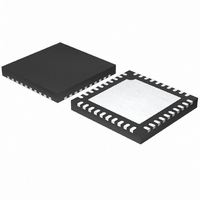MAX1566ETL+ Maxim Integrated Products, MAX1566ETL+ Datasheet - Page 28

MAX1566ETL+
Manufacturer Part Number
MAX1566ETL+
Description
IC DGTL CAM PWR-SUP 6CH 40TQFN
Manufacturer
Maxim Integrated Products
Datasheet
1.MAX1567ETLT.pdf
(35 pages)
Specifications of MAX1566ETL+
Applications
Controller, Digital Camera
Voltage - Input
0.7 ~ 5.5 V
Number Of Outputs
7
Voltage - Output
1.25 ~ 5 V
Operating Temperature
-40°C ~ 85°C
Mounting Type
Surface Mount
Package / Case
40-TQFN Exposed Pad
Lead Free Status / RoHS Status
Lead free / RoHS Compliant
Six-Channel, High-Efficiency, Digital
Camera Power Supplies
The inductor is typically selected to operate with contin-
uous current for best efficiency. An exception might be
if the step-up ratio, (V
D
of 80%.
When using the step-up channel to boost from a low
input voltage, loaded startup is aided by connecting a
Schottky diode from the battery to PVSU. See the
Minimum Startup Voltage vs. Load Current graph in the
Typical Operating Characteristics.
In most step-up designs, a reasonable inductor value
(L
which sets continuous peak-to-peak inductor current at
1/2 the DC inductor current:
where D is the duty factor given by:
Given L
rent is 0.5 I
I
Inductance values smaller than L
reduce inductor size; however, if much smaller values
are used, inductor current rises and a larger output
capacitance may be required to suppress output ripple.
The inductor and output capacitor are usually chosen
first in consideration of performance, size, and cost. The
compensation resistor and capacitor are then chosen to
optimize control-loop stability. In some cases, it may
help to readjust the inductor or output-capacitor value to
get optimum results. For typical designs, the component
values in the circuit of Figure 1 yield good results.
The step-up converter employs current-mode control,
thereby simplifying the control-loop compensation.
When the converter operates with continuous inductor
current (typically the case), a right-half-plane zero
appears in the loop-gain frequency response. To
ensure stability, the control-loop gain should cross over
(drop below unity gain) at a frequency (f
than that of the right-half-plane zero.
The relevant characteristics for step-up channel com-
pensation are as follows:
• Transconductance (from FB to CC), gm
• Current-sense amplifier transresistance, R
• Feedback regulation voltage, V
• Step-up output voltage, V
28
IND(PK)
MAX
IDEAL
(0.3V/A)
L
______________________________________________________________________________________
), where D
IDEAL
) can be derived from the following equation,
IDEAL
= 1.25 I
= [2V
OUT
, the consistent peak-to-peak inductor cur-
OUT
MAX
/ (1 - D). The peak inductor current,
IN(MAX)
D = 1 - (V
/ (1 - D).
is the maximum PWM duty factor
OUT
x D(1 - D)] / (I
/ V
IN
SU
IN
/ V
, in V
Step-Up Compensation
), is greater than 1 / (1 -
OUT
IDEAL
FB
(1.25V)
)
Step-Up Inductor
OUT
can be used to
EA
C
) much less
x f
(135µS)
OSC
)
CS
• Output load equivalent resistance, R
The key steps for step-up compensation are as follows:
1) Place f
2) Select R
3) Calculate the output-filter capacitor (C
4) Determine if C
For continuous conduction, the right-half-plane zero fre-
quency (f
where D = the duty cycle = 1 - (V
inductor value, and I
rent. Typically target crossover (f
For example, if we assume f
V
select L = 4.7µH, then:
f
Choose f
C
Choose 6.8nF.
Now select R
met. As an example, if 4% transient droop is allowed,
the input to the error amplifier moves 0.04 x 1.25V, or
50mV. The error-amp output drives 50mV x 135µS, or
6.75µA, across R
current-sense transresistance is 0.3V/A, the value of R
that allows the required load-step swing is as follows:
In a step-up DC-to-DC converter, if L
put current relates to inductor current by:
So, for a 500mA output load step with V
V
Note that the inductor does not limit the response in this
case since it can ramp at 2.5V / 4.7µH, or 530mA/µs.
The output filter capacitor is then chosen so the C
R
RHPZ
I
OUT
OUT
LOAD
C
IND(PK)
V
(RHPZ) and calculate C
R
sponds to load-current step.
to allow the R
>10pF).
OUT
= (V
= (1.25 / 5)(10 / 0.3) x [135µS / (6.28 x 14kHz)] (2/5)
= 6.4nF
R
C
C
= 5V, and I
= 5V:
= 5 (2.5 / 5)
sets a voltage delta on the C
= [1.25(0.3 x 0.5 x 5) / 2)] / 6.75µA = 69.4kΩ
pole cancels the R
/ I
f
FB
C
RHPZ
RHPZ
= 1.25 I
LOAD
C
= 14kHz. Calculate C
C
/ V
sufficiently below the right-half-plane zero
based on the allowed load-step transient.
C
) is given by the following:
= V
OUT
R
C
C
C
OUT
so transient-droop requirements are
OUT
OUT
C
2
OUT
= 0.3 I
and C
)(R
P
/ (2π x 4.7 x 10
to provide transient gain. Since the
LOAD
x R
is required (if calculated to be
LOAD
/ (1 - D) = 1.25 I
(1 - D)
= 0.5A, then R
LOAD
C
IND(PK)
C
selected.
C
is the maximum output cur-
/ R
C
.
OSC
2
C
/ (2π x L x I
= R
CS
zero:
C
/ 6.75µA
C
= 500kHz, V
)(gm / 2π x f
:
C
-6
) for 1/6 of the RHPZ.
IN
x C
x 0.5) = 84.65kHz
LOAD
IDEAL
OUT
C
/ V
C
pin that corre-
LOAD
IN
OUT
LOAD
OUT
x V
= 10Ω. If we
is used, out-
= 2.5V and
OUT
), L is the
) required
IN
)
C
, in Ω =
)(1 - D)
= 2.5V,
/ V
OUT
IN
C











